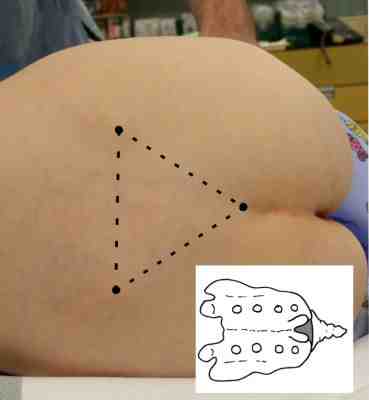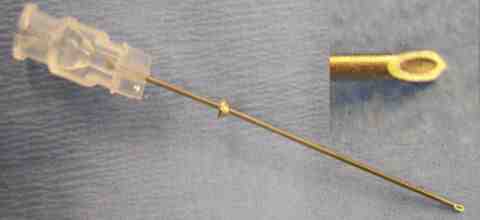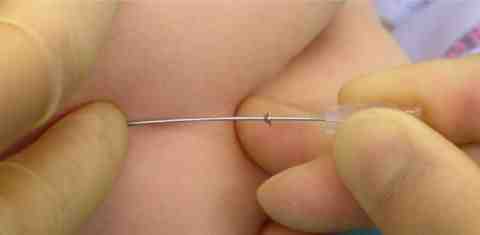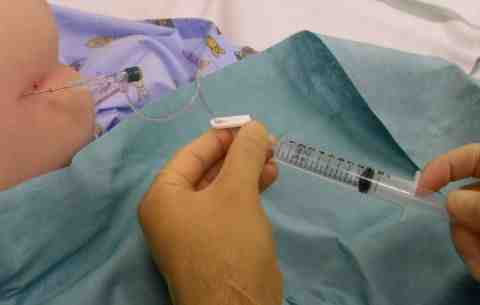Caudal anaesthesia is effectively a single shot epidural, performed via the sacro-coccygeal membrane, which is at the inferior point of the sacrum (see images). Because the thecal sac does not extend into the sacrum, this technique is suitable for use in children. The block is usually performed after induction of general anaesthesia. The same general precautions as for epidural analgesia should be observed.
Caudal anaesthesia is effectively a single shot epidural, performed via the sacro-coccygeal membrane, which is at the inferior point of the sacrum (see images). Because the thecal sac does not extend into the sacrum, this technique is suitable for use in children. The block is usually performed after induction of general anaesthesia. The same general precautions as for epidural analgesia should be observed.
Stage 1
The approximate position of the sacro-coccygeal membrane is at the inferior point of an equilateral triangle, whose other two points are the posterior superior iliac spines. The two knobbly sacral cornua sit either side of the sacro-coccygeal membrane and act as palpable landmarks in its location. Inset: The sacro-coccygeal membrane (shaded), bounded by the cornua.

Caudal anaesthesia is effectively a single shot epidural, performed via the sacro-coccygeal membrane, which is at the inferior point of the sacrum (see images). Because the thecal sac does not extend into the sacrum, this technique is suitable for use in children. The block is usually performed after induction of general anaesthesia. The same general precautions as for epidural analgesia should be observed.
Stage 2
Commonly a regional block needle is used (top), which has a shortened bevel to give a better sensation of the needle tip's passage through tissue planes (see inset).

Caudal anaesthesia is effectively a single shot epidural, performed via the sacro-coccygeal membrane, which is at the inferior point of the sacrum (see images). Because the thecal sac does not extend into the sacrum, this technique is suitable for use in children. The block is usually performed after induction of general anaesthesia. The same general precautions as for epidural analgesia should be observed.
Stage 3
The needle is inserted first at an angle of around 30 degrees to the skin, angled cephalad. Once the needle has passed through the membrane (usually signalled by a slight loss of resistance to advancement), the angle is reduced and the needle advanced further cephalad.

Caudal anaesthesia is effectively a single shot epidural, performed via the sacro-coccygeal membrane, which is at the inferior point of the sacrum (see images). Because the thecal sac does not extend into the sacrum, this technique is suitable for use in children. The block is usually performed after induction of general anaesthesia. The same general precautions as for epidural analgesia should be observed.
Stage 4
As with epidural anaesthesia, aspiration is performed before injecting, to exclude venous placement. The dose used depends upon the intended surgery. As with epidurals, an opioid can be added if desired. Typically, 10-20 ml of bupivacaine 0.25% or 0.5% might be used for an adult. Smaller doses are used in children and mL/kg dose tables are available.
